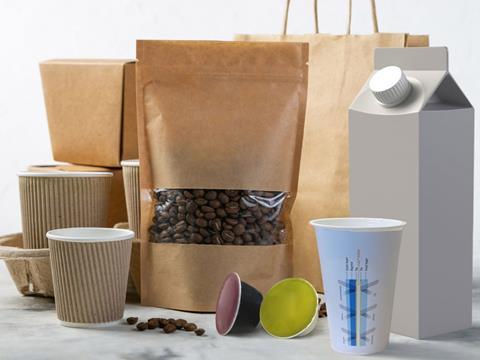
Kuraray has developed PLANTIC EP, a repulpable, plant-based granulate designed for extrusion coating – a solution set to provide gas- and aroma-barrier solutions for paper and cardboard packaging without impacting their recyclability.
Kuraray’s PLANTIC barrier materials are produced from starch and can be used in recyclable and compostable packaging formats. Its gas barrier properties are expected to prolong the shelf life of perishable products, and because it is made from renewable, plant-based materials, it is anticipated to enable the reuse of materials that could not previously be recycled.
As an additional grade of this range, PLANTIC EP has been applied to kraft paper using the extrusion process with a bonding/heat-sealing layer of polyethylene from Westlake – resulting in a series of flexible pouches, cartons, and multi-layer films with high-barrier properties. The additional structural layers can reportedly be separated, reused, and recycled or composted where appropriate.
This collaboration has been awarded a certificate confirming its repulpability and recyclability by Western Michigan University (WMU), meaning that the granulate can be used in barrier pouch and carton formats while remaining recoverable and recyclable in the US paper waste stream.
“In this collaboration with Kuraray, we used all our application development resources to create a really unique offering,” says Amy Moore, vice president of Westlake. “We see the benefits of Kuraray’s technology and look forward to working together on further developments as Kuraray commercialises the technology across the bandwidth of market segments and categories.”
“Companies have recognised the importance of packaging that maintains product integrity and shelf life, while consumers don’t want to buy products that add to landfills,” says Tom Black from Kuraray’s PLANTIC unit. “We noticed a gap in the market and the need for a sustainable material that could be used to produce pouches and cartons with high barrier properties. It was clear that PLANTIC EP could be a game-changer.
“As well as complementing customers’ and retailers’ dynamic product ranges, PLANTIC EP helps them achieve their sustainability goals – thanks to certification from Western Michigan University that it is both repulpable and recyclable, enabling us all to leave behind a better world for our children.
“WMU certification as confirmation of recyclability is an important first step in securing a How2Recycle label. When developing packaging formats for brand owners, producers want to see that the materials they are using have been vetted by WMU. Certification enables them to apply to How2Recycle for a pre-validation letter, which speeds up the introduction of PLANTIC EP-based high-barrier solutions.”
PLANTIC EP is available for testing, with its recyclability in European recycling streams currently being assessed.
Back in February, Mondi revealed its FunctionBarrier range of medium, high, very high-barrier paper-based packaging, which claimed to be a recyclable substitute for multi-material, aluminium-based alternatives and unrecyclable plastic laminates.
In addition, ExxonMobil, Henkel, Kraus Folie, Siegwerk, and Windmöller & Hölscher designed a fully-recyclable, high-barrier PE pouch with similar properties to its multi-material laminated alternatives.
If you liked this article, you might also enjoy:
McKinsey on whether or not on-pack sustainability claims affect consumer spending
A deep dive into the most important packaging sustainability trends and solutions











No comments yet